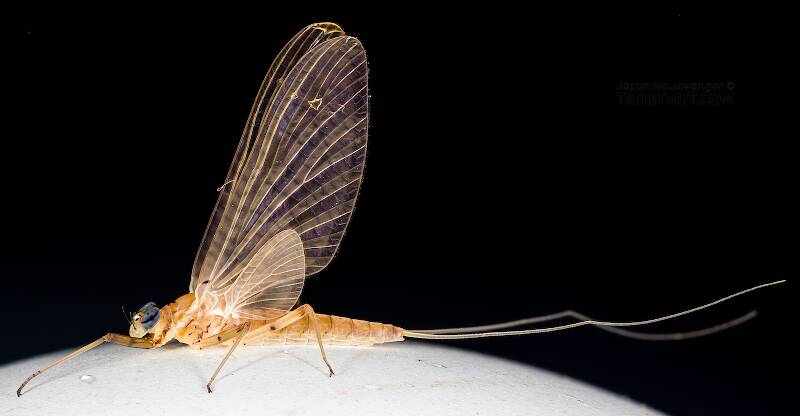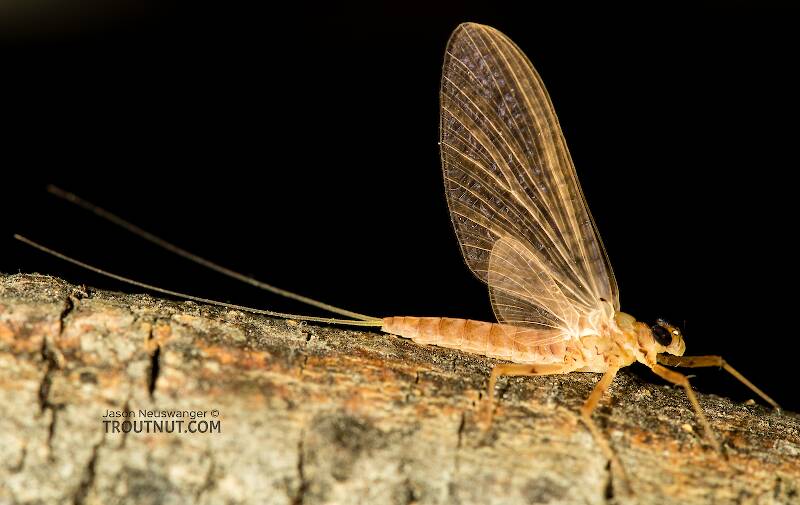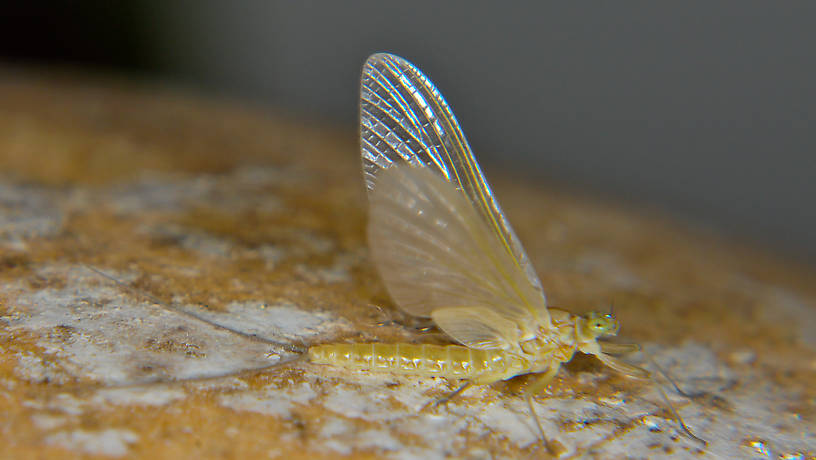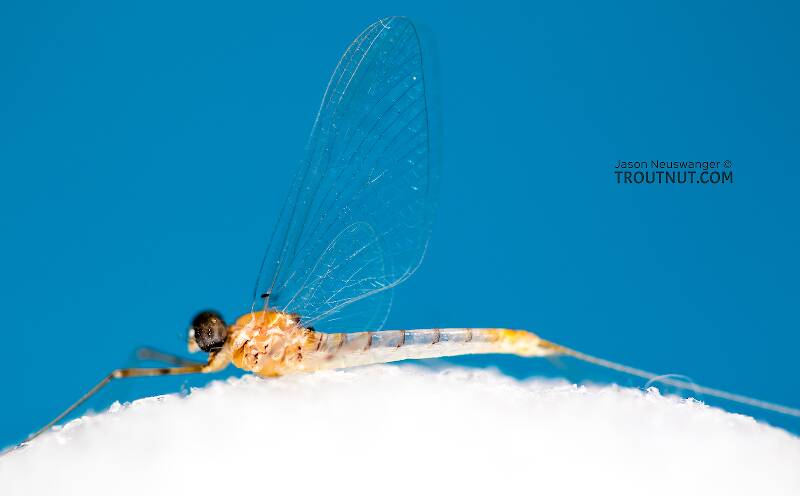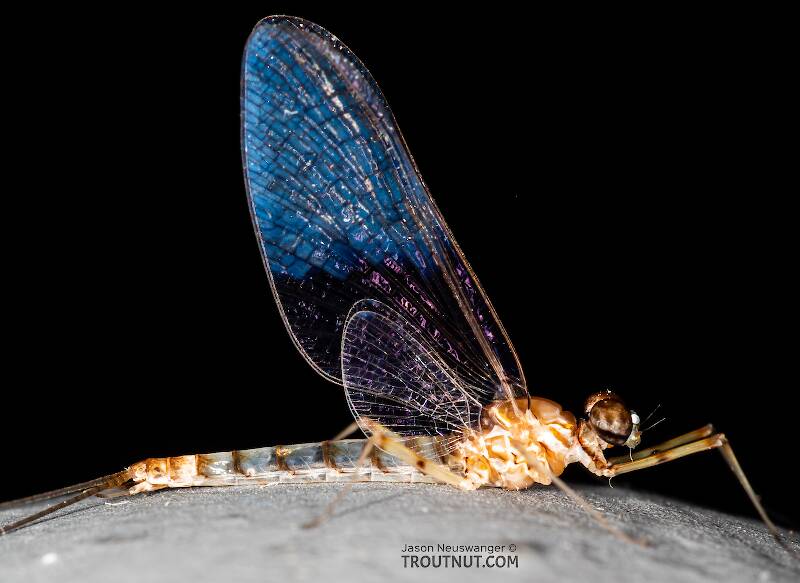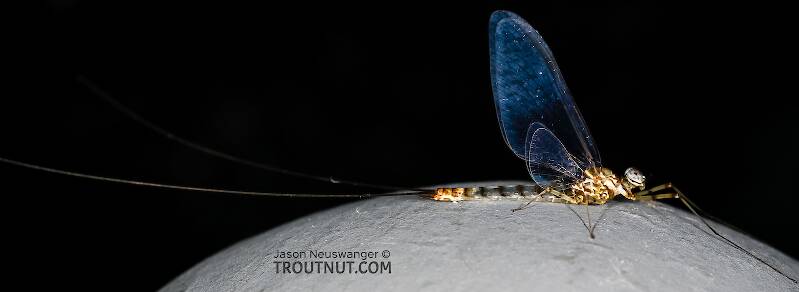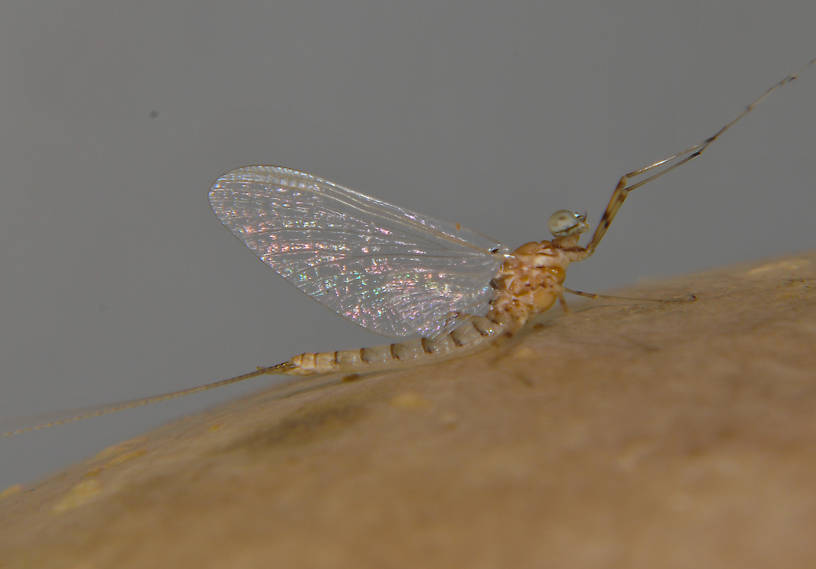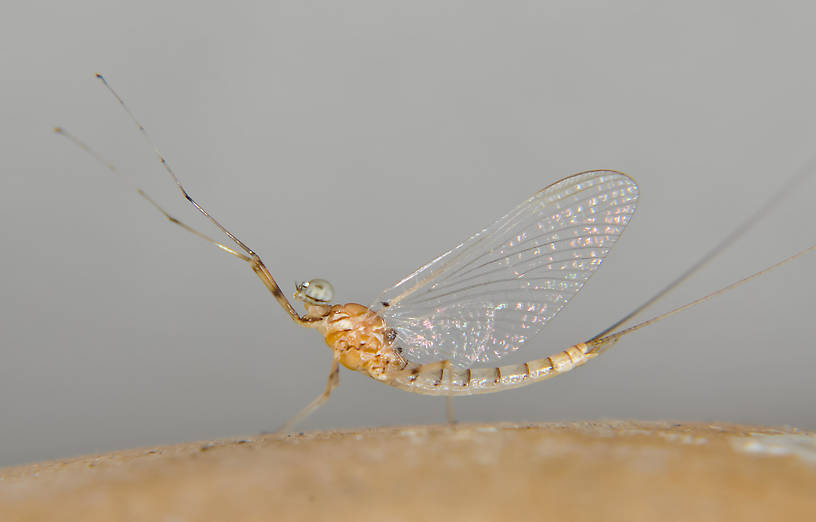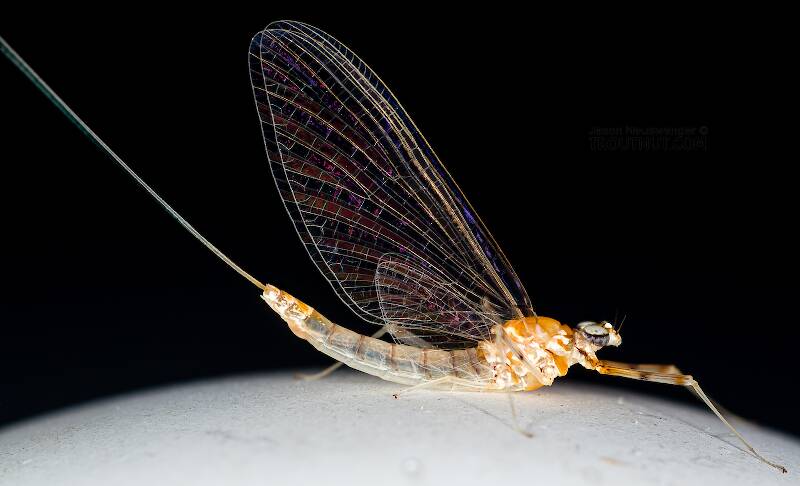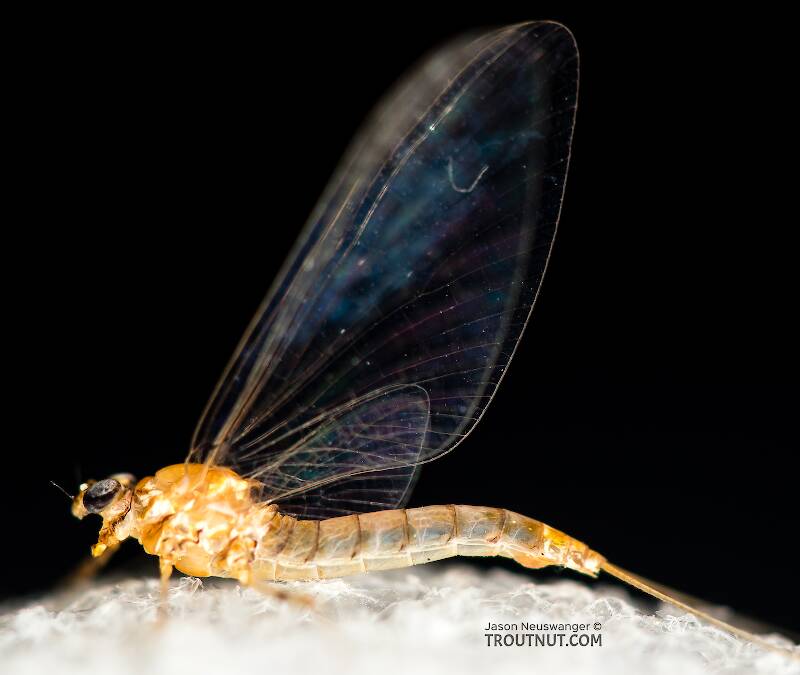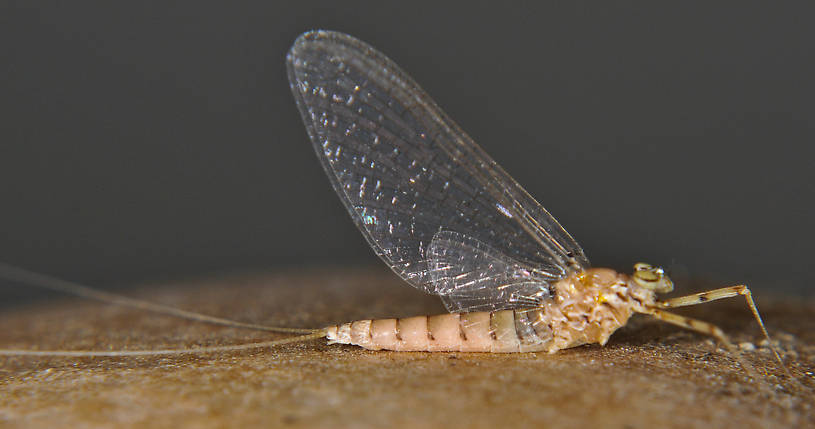
Salmonflies
Pteronarcys californica
The giant Salmonflies of the Western mountains are legendary for their proclivity to elicit consistent dry-fly action and ferocious strikes.
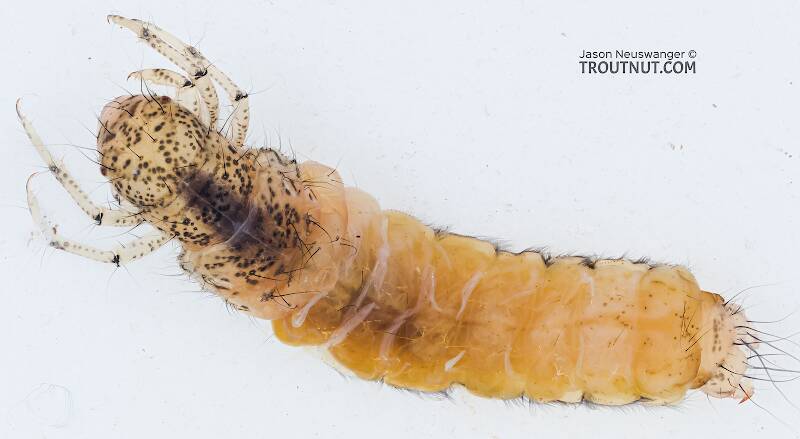
- The prosternal horn is present.
- The mandible is clearly toothed, not formed into a uniform scraper blade.
- The seems to be only 2 major setae on the ventral edge of the hind femur.
- Chloride epithelia seem to be absent from the dorsal side of any abdominal segments.
Based on these characteristics and the ones more easily visible from the pictures, this seems to be Grammotaulius. The key's description of the case is spot-on: "Case cylindrical, made of longitudinally arranged sedge or similar leaves," as is the description of the markings on the head, "Dorsum of head light brownish yellow with numerous discrete, small, dark spots." The spot pattern on the head is a very good match to figure 19.312 of Merritt R.W., Cummins, K.W., and Berg, M.B. (2019). The species ID is based on Grammotaulius betteni being the only species of this genus known in Washington state.

Mayfly Species Epeorus albertae (Pink Ladies)
Where & when
Time of year : July through August
Preferred waters: Slower than other mountain Epeorus species
Altitude: 5,000 to 6,000 feet
In 19 records from GBIF, adults of this species have been collected during July (47%), June (26%), September (21%), and August (5%).
In 17 records from GBIF, this species has been collected at elevations ranging from 3248 to 8415 ft, with an average (median) of 5358 ft.
Species Range
Hatching behavior
Water temperature: Warmer than other Western Epeorus species
Spinner behavior
Time of day: Early morning or late afternoon/evening
Nymph biology
Current speed: Fast
Physical description
Most physical descriptions on Troutnut are direct or slightly edited quotes from the original scientific sources describing or updating the species, although there may be errors in copying them to this website. Such descriptions aren't always definitive, because species often turn out to be more variable than the original describers observed. In some cases, only a single specimen was described! However, they are useful starting points.
Male Spinner
Wing length: 10-11 mm
Eyes of living insect blue-grey. Thorax light brown; mesonotum with a central darker band which spreads out on posterior portion “where there is a median spot of pale ochreous” (McD.). No dark markings on pleura. Legs pale brown; all femora with dark spot near middle. Fore femur and tibia subequal. Tip of fore tibia blackish, other joinings dark brown. Wings hyaline; venation pale brown, fine, inconspicuous; humeral cross vein marked with blackish. Abdominal tergites 2-6 semi-hyaline, slightly smoky; posterior margins narrowly brown. Sternites 2-7 pale hyaline, with faint traces of dark spots at ganglionic areas. Segments 8-10 opaque; tergites brown, sternites creamy. Forceps creamy, brown at apex. Tails brown. Apical margin of forceps base somewhat excavated laterally. Divisions of penes not lobed, as in I. longimanus (now a synonym of Epeorus longimanus); laterally each division is prolonged into a beak-like process; see fig. 107. Median spines rather stout, slightly divergent apically; shorter than in Iron lagunitas (now a synonym of Epeorus lagunitas).
Described as I. youngi
Body length 10 mm, wing length 10-11 mm
Allied to I. albertae (now a synonym of Epeorus albertae), but with shorter fore femur, black spiracular markings and black markings on thoracic pleura.
Head pale yellowish. Thorax fawn-colored. Anterior, posterior and postero-lateral margins of pronotum narrowly black; posterior portion somewhat smoky. Median olive brown streak on mesonotum. Tip of scutellum blackish, also posterior margins of mesonotum and depressions on each side of scutellum. Pale area anterior to scutellum; on each side of this, an olive brown area. Metathoracic scutellum and posterior margin of sclerite blackish. A brownish black streak extends downward from lateral margin of pronotum to base of fore leg. An oblique black streak on pleura anterior to root of fore wing; narrow black pencilings above, anterior and posterior to middle and hind coxae. A small black dot on each coxa. Legs yellowish. A prominent black spot at middle of each femur, and traces of a reddish brown or blackish apical band on each; this may be reduced to a small dark spot on ventral margin. Apex of fore tibia, all claws, and joinings of fore tarsus, blackish. Fore femur about as long as tibia. Femora may be faintly tinged with red. Wings hyaline; venation very pale brown. Basal costal cross veins indistinct, especially at costal margin; cross veins between bulla and stigmatic area obsolescent. Stigmatic cross veins well developed, slightly aslant, not anastomosed, about 14 in number. Humeral cross vein deep purplish black in posterior 2/3 of its length; pale next to costal margin.
Abdominal segments 2-7 semi-hyaline, whitish, faintly washed with pale brown. Posterior margins of tergites narrowly purplish black, most distinct dorsally. Median and lateral areas of tergites faintly brown-shaded; anterior margins and antero-lateral angles pale. A curved black streak, cutting across the postero-lateral angle on each side, divides into two branches at spiracle, so that a pale oval area is enclosed by black lines, as in I. hesperus (now a synonym of Epeorus hesperus). Ganglionic areas on sternites very faintly marked with brown. Abdominal segments 8-10 opaque, fawn-colored like thorax. Tails pale brown; apical portion of each joint is slightly deeper brown. Genitalia very much as in I. albertae (See fig. 107).
The black markings on thorax and spiracular areas of abdomen, and the more distinct median femoral spot, distinguish this species from I. albertae and I. lagunitas (now a synonym of Epeorus lagunitas). The fore femur is also shorter than in the former species. The very indistinct costal cross veins basal of the stigmatic area separate this species from I. sancta-gabriel (now a synonym of Epeorus hesperus) to which it is closely allied. It seems to be allied also to I. hesperus (now a synonym of Epeorus hesperus) but the dark posterior margins of the tergites and the faint brown markings at ganglionic areas of sternites should distinguish it from that species.
Specimens of the Mayfly Species Epeorus albertae
1 Male Dun
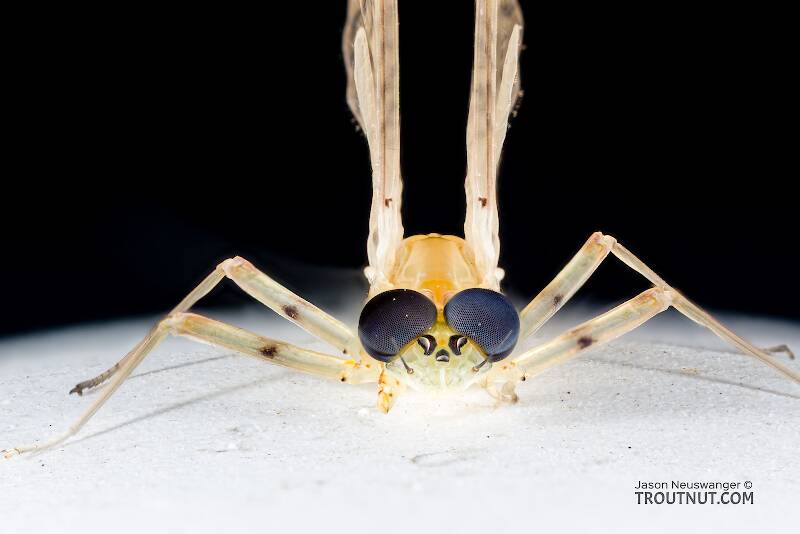
3 Female Duns
5 Male Spinners
3 Female Spinners
1 Nymph

Start a Discussion of Epeorus albertae
References
- Arbona, Fred Jr. 1989. Mayflies, the Angler, and the Trout. Nick Lyons Books.
- Caucci, Al and Nastasi, Bob. 2004. Hatches II. The Lyons Press.
- Knopp, Malcolm and Robert Cormier. 1997. Mayflies: An Angler's Study of Trout Water Ephemeroptera . The Lyons Press.
- Merritt R.W., Cummins, K.W., and Berg, M.B. 2019. An Introduction to the Aquatic Insects of North America (Fifth Edition). Kendall/Hunt Publishing Company.
- Needham, James G., Jay R. Traver, and Yin-Chi Hsu. 1935. The Biology of Mayflies. Comstock Publishing Company, Inc.
- Schwiebert, Ernest G. 1955. Matching the Hatch. MacMillan Publishing Company.
- Swisher, Doug and Carl Richards. 2000. Selective Trout. The Lyons Press.
Mayfly Species Epeorus albertae (Pink Ladies)
Species Range
Common Names
Resources
- NatureServe
- Integrated Taxonomic Information System
- Global Biodiversity Information Facility
- Described by McDunnough (1924)


